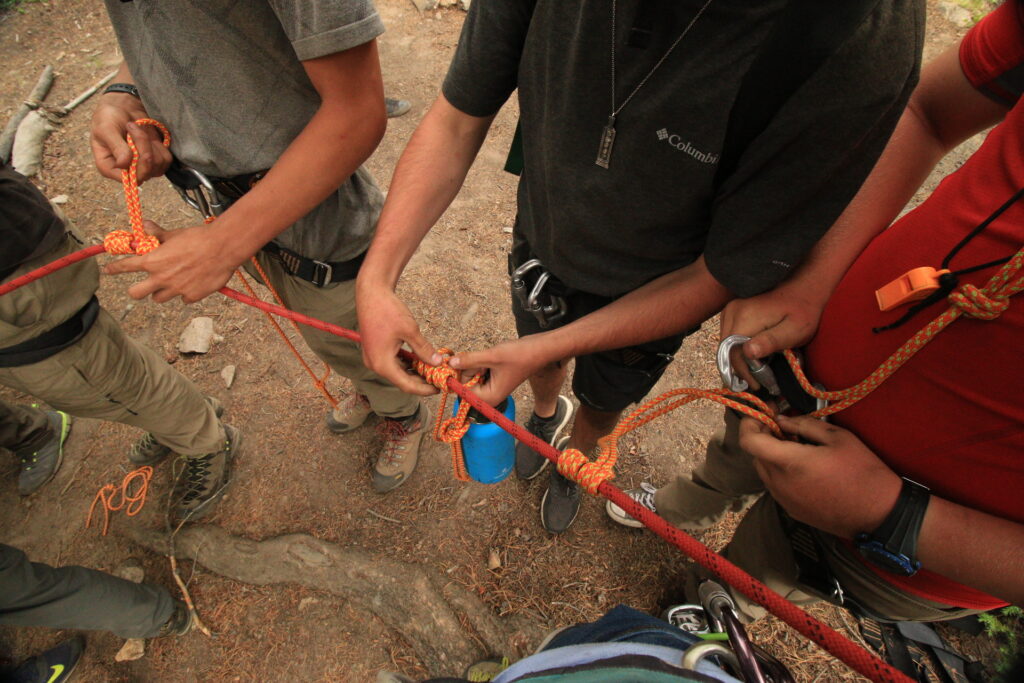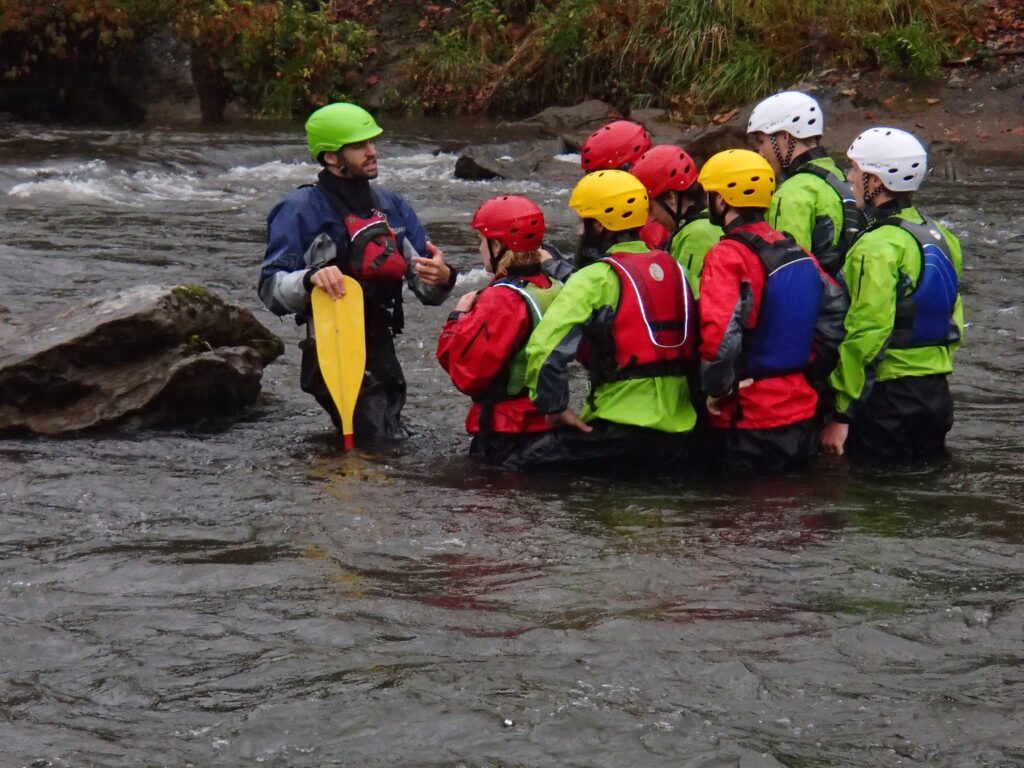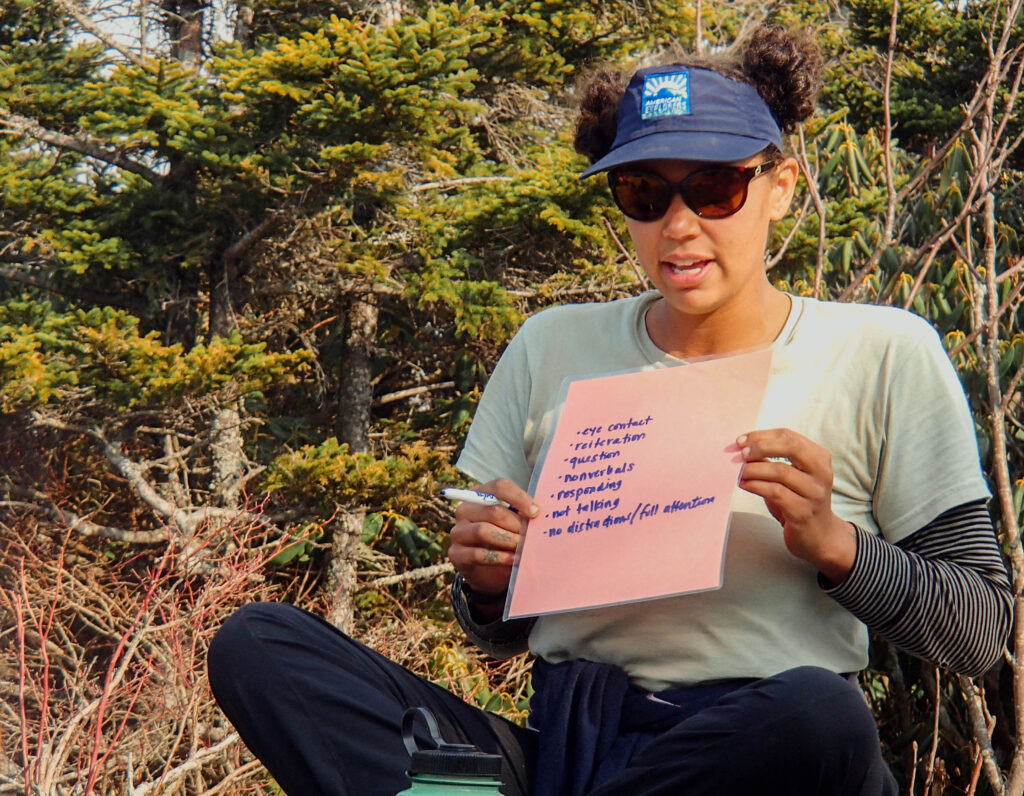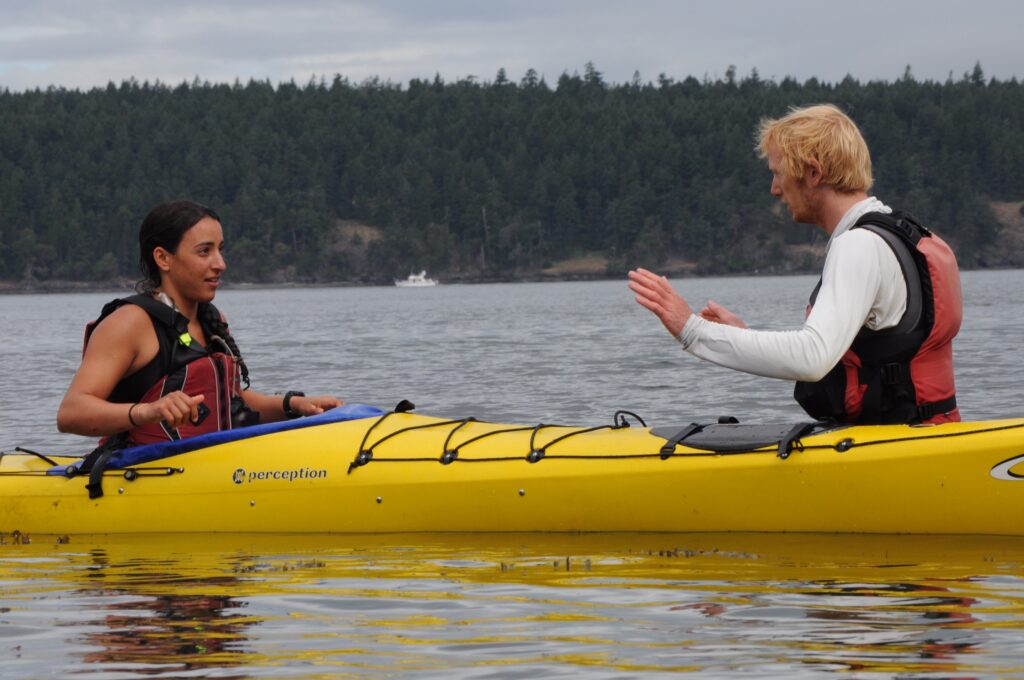How to understand different learning styles and why it’s important in empowering students to succeed.
It took me a while to learn how to tie knots. It’s an essential outdoor technical skill that I lacked before becoming an Outward Bound Instructor, but not due to lack of effort. I can’t count the number of times I had asked friends and colleagues to show me how to tie a bowline, a trucker’s hitch, a half hitch, the list goes on.
I’d watch while their fingers and the rope moved so quickly it was like magic, and almost just as quickly, I went from determined to defeated. When I realized I wasn’t able to figure it out by watching them do it, I tried mirroring them. I’d stand side by side with them and attempt to make the knot on my own rope, while they modeled on theirs how to do it. Still, I couldn’t make the magic happen.
Finally, my sweet friend told me a story.

Students practice tying Prusik Knots. Photo by Alexa Geider
The Bunny Story
“The bunny comes up from its hole, goes around the tree, and back into its hole.”
That simple anecdote about the rabbit and the tree described the ways I needed to maneuver the rope in order to tie a bowline. The working end of the rope moved up and around and down the static end, and then through itself. Just like that, I became an expert in the bowline, which boosted my confidence and propelled me to absorb and memorize how to tie all the other classic, commonly used knots. Soon the student became the teacher and I taught everything from how to tie canoes to a trailer, to how to put up a clothesline and a tarp.
It was extremely empowering to finally learn a skill I struggled with for so long. And it all came together when an intuitive mentor realized my learning style wasn’t being catered to. I needed to hear how to do it, not just see it and not just do it.
Exploring Three Different Learning Styles
There are three main ways to learn: visually, auditorily and kinesthetically.
Visual learners tend to excel at picking up information when it’s presented to them visually. This is someone who could watch someone tie a bowline knot and then be able to do it themselves.
Auditory learners tend to excel when presented with information auditorily. Simply hearing the information can be enough for this person. This is someone who needs the bunny story or just a detailed explanation of what to do with the rope to make the bowline knot.
Kinesthetic learners are active learners. They may need to be physically involved in the presentation of information in order for them to retain it. This is someone who needs to practice tying the bowline knot themselves in order to retain the steps.

Photo by Jesse Swedlund.
Lessons On an Outward Bound Course
There are countless lessons to be learned on an Outward Bound course, and lessons are taught to all three learning styles so that every participant can absorb the information. Some lessons are obviously necessary—like how to pack your backpack, tie yourself in for rock climbing or how to distribute your weight in a white-water canoe. Other lessons are less obviously needed—like how to resolve conflict with a passive-aggressive crewmate, why you haven’t wanted to write a letter home to your parents or why you’re struggling to speak up even though you know your crew is hiking in the wrong direction.
Teaching Every Type of Lesson for All Learning Styles
The more obvious lessons are built into the expedition schedule. Every time something happens for the first time on an Outward Bound course, Instructors pause the expedition to brief students on what’s coming up. For example, the first time the crew sets up camp, Instructors teach students how to set up their tents, how to store food, where to go to the bathroom, how to wash up after dinner, etc. These are all things that must be taught and learned because if they aren’t done properly, it would risk the safety of the crew.
As a way to incorporate all learnings styles, rather than just showing students how to set up a bear hang, for example, or telling students how to do it or showing them, Instructors might do all three in their bear hang lesson.

The less obvious, necessary, lessons are also taught as needed, but usually in response to what’s going on with the crew. For example, if a crew is struggling to communicate directly and respectfully with one another and that deconstructive communication is hindering peoples’ experiences, Instructors will pause the expedition to address the issue. These types of life skills can be taught in the same way as technical skills—by addressing all three learning styles.
As an Instructor, I’ve taught life skills, like constructive communication, by acting out examples of communication, asking students what they witnessed in my performance, writing down their answers on a whiteboard for everyone to see, and having students act out both positive and negative ways of communicating. This example incorporated all learning styles while delivering an important message.

An Instructor presents a lesson on positive communication.
No matter what skills you’re hoping to learn on an Outward Bound course, you’re going to get even more than you bargained for. Being in the field minimizes distractions and maximizes the highs and lows we all feel constantly. With so much time and space devoted solely to the experience and personal development, the learning opportunity is endless. When presented with information in the most beneficial way for your learning style, you’re bound to come away from the experience having learned and grown.
Other Tips for Learning
All of us, regardless of our specific preferred learning styles, can benefit from additional tricks when taking in new information.
One important practice is checking for understanding. This means explaining something back to the person who just taught it to you to check that you comprehend the material. Sometimes that looks like observing a lesson first before jumping in and trying something new. Other times it requires that the student process the information and come back to it later. Sometimes it means the student participates by taking notes and then having their teacher check their notes.
Checking for understanding is important on any Outward Bound course because much of what we learn becomes knowledge that keeps us prepared in the backcountry and throughout our expedition. It’s also important because we often learn in progression, meaning a simple idea will later be expanded upon, so the first phase needs to be understood before moving on to the second phase.
Similarly, a seventh-grader needs to pass the seventh grade before moving on to eighth grade. So checking for understanding is just as essential in the frontcountry. Checking for understanding in a classroom setting may be a pop quiz, an essay on the book your class just read or a group project at the end of the semester.
It can be helpful for students to know there is a reason behind every graded assignment, such as to confirm that the student understands the material and is ready to move forward in the curriculum.

Photo by Anna Sand
Transference to School
The classroom setting is not a one-size-fits-all experience. Teachers have worked tirelessly throughout the pandemic as we transitioned from complete uncertainty to virtual programming to in-person classes.
Having the language to express what kind of learner you are (or your child is) can be valuable when talking with teachers. If you (or your child) are struggling to learn from a mentor or teacher, you can better advocate for what you need by asking for visual aids, more verbal explanation or physical engagement.
For example, you can say something like, “I’m a kinesthetic learner, so can you try explaining that to me in a way that I can participate and move around while I’m learning?” Or, “I’m a visual learner, can we make a checklist of the assignment so I can see my expectations and check things off as I complete them?”
“We all learn at different rates and in different ways. It’s ok to need to hear the bunny story even if your peers can tie a bowline after seeing it done once.”
Of course, it’s easier to learn about topics that are relevant and interesting to you. It may be hard to care about algebra when you hate math but love reading. But hopefully, with the ability to meet your learning needs, you can find ways to set yourself up for success in all areas.
We all learn at different rates and in different ways. It’s ok to need to hear the bunny story even if your peers can tie a bowline after seeing it done once. It’s ok to check for understanding and be wrong—that’s why we check. It’s ok to sometimes be the teacher and other times the student. We all have something to learn from each other, and we’re all going to learn differently. What’s important is that we keep our minds open and are willing to try to absorb new information.
Outward Bound Intercept Courses
Although all Outward Bound expeditions deliver a well-rounded teaching approach, Outward Bound Intercept courses can be a great experience for a student whose learning needs may not be getting met at school, and consequently, may be struggling. Students can benefit from a wilderness expedition where they discover themselves and their specific learning needs. For more information about Intercept courses, click here.
About the Author
Elizabeth Bowling is a Field Instructor for the North Carolina Outward Bound School. Elizabeth has a degree in journalism and international studies from the University of Connecticut.




